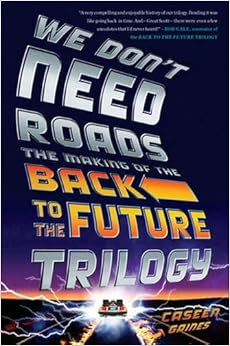
The title: We Don't Need Roads: the Making of the Back to the Future Trilogy
The author: Caseen Gaines
Publication: Penguin, 2015
Got it from: Amazon
The author: Caseen Gaines
Publication: Penguin, 2015
Got it from: Amazon
How much do I love the Back to the Future trilogy? You don't want to know. They are hands-down, by a long shot, far and away my favourite movies. I have watched them dozens of times since the early 1990s and practically know them line for line. I've often pondered why I love them so much. Is it the incredibly written scripts, where every scene has purpose and meaning? Is it 80s nostalgia? Is it that the characters are so great I want to visit and revisit them constantly? Maybe it's all of those and more. There is also of course my deep and abiding love of time travel. Chicken and egg question: did my love of time travel spring from these movies or did I love them because they had time travel? I was so young the first time I saw them. I doubt I'll ever be able untangle that conundrum.
And honestly, who cares? It's enough to just love them. Every time I see them I notice something new. It doesn't matter that I know exactly how they end, I still find them thrilling. (My personal opinion: the train scene at the end of Part III is the most exciting action sequence in cinematic history). They are somehow childhood comfort and adult appreciation at the same time. Another paradox, just like the films love to mention.
I could go on pretty much forever dissecting these films. No, really, I could. Don't get me started down that path. Suffice to say, when I found out there was going to be a 30th anniversary retrospective book, I said, "shut up and take my money." Because let's be honest, there's a pretty slim chance I wasn't going to enjoy this book.
Now, as a disclaimer, I'm going to admit that you should probably be a fan before you read this book. The author doesn't describe the plot in a huge amount of detail. You're going to have to know what "the lightning scene" or the "Enchantment Under the Sea" dance are, for example (as in "this was what happened when they filmed that scene.") But who the heck even reads a making of book without having seen the movies first anyway? Now that I've gotten that out of the way, I can say that if you are a big BTTF fan, you'll love it. It's not entirely gossip, but there are some pretty juicy details, like just what Crispin Glover asked for that prevented him from being in the sequels and what really happened with Eric Stoltz. I like that they interviewed some of the smaller memorable characters too, like Marvin Barry and the Wallet Guy, to get their perspective on what it was like to be in these iconic films. I also have a new appreciation for just how much work Robert Zemeckis (aka Bob Z) and Bob Gale had to put in to make these films so perfect. Overall, I really like the way the author framed the narrative. I was impressed with how he kept the story flowing and made it interesting. I thought I knew pretty much all there was to know about these movies but I was wrong.
Verdict: Set your De Lorean time circuits and get the flux capacitor fluxing. October 21, 2015, the day Doc and Marty travel to the future, will be here in just two months. While you're waiting, I suggest reading We Don't Need Roads to get your BTTF fix.

